
Andy remained ever conscious of what was going on in the field. Even in "styles" unlike what developed into his own. Work such as the decorative delights of Martin and Alice Provensen, great Pushpin Almanac graphics by Milton Glaser in the mid-1950s. Art book salesmen came regularly to Rahl Studios with wonderful books the illustrators often bought. I still have one Andy bought: The Fireside Book of Favorite American Songs (Simon & Schuster ,1952) illustrated by Aurelius Battaglia whose 2-dimensional illustrations charmed him. As did the whimsical work of Homer Hill in Lithopinion 9.
Among those he admired were Joe de Mers, Joe Bowler, Coby Whitmore, Bob Peak, Al Parker, of course, and later, the extraordinary Bernie Fuchs. Bits and pieces are always picked up by the creative individual and absorbed. We all stand and launch out from the shoulders of the great ones.

But I am ahead of the story. Only months after arriving at Rahl Studios in the autumn of 1952, in February 1953 Andy was hospitalized with pulmonary tuberculosis. This completely removed him from the illustration field for one and a half years!
What offset that horrible occurrence – if anything could just as you are making it to the top – was that from that time on, we knew we mattered to one another. Immensely. Our ‘romance’ was certainly the weirdest and most frustrating: letters during the time he was contagious and phonecalls whenever he was allowed out of bed to call me. And then, when he was not contagious, visits to the Brooklyn Veteran’s Hospital. And all this relationship was kept very private.
My best friend (my mother thought I would marry him) lived two blocks away from me in NYC. He "covered" for me whenever I took the very long subway trips from the city to Brooklyn to see Andy. By night, I would return to his apartment, in tears and despair, and he would fix me a grilled cheese sandwich with tomato slices and oregano on top. Broiled. Once I had eaten and calmed down, he would walk me home up Fifth Avenue and then to my apartment near Madison Ave. where my mother greeted both of us happily after our all-day-long "date." She was very concerned that Andy was in touch with me at all. (This lovely buddy of mine, Robert Dalton Freed, my best friend from before I met Andy is still my oldest friend – and in recent years, my neighbor here in Forest, Virginia. He remains, 50 years later, like my brother.)
NOTE: I was devastated when he suddenly died this past December 28, 2006. I fully expected him to read this work on Andy in a short time. He knew about it, but I wanted to surprise him and never showed him a preview. He had been an editor on Popular Electronics magazine and in later years was with Bell Labs in New Jersey. A.V.
There was one lucky bit of timing for Andy’s illness. At last the discovery was made that could cure tuberculosis. In 1952, a combination of the drugs streptomycin and INH worked. But beyond that, and because we hoped to marry, Andy did not wish us to have to live with a sword of Damocles over our heads. He therefore willingly underwent surgery for removal of the damaged lobe and segment of his affected lung. I was aghast when he told me he was going to do this! He was determined.
Then, because of all the aspirin he had been taking for back pain over the years, he nearly hemorrhaged to death on the operating table during that surgery. Thereafter, on a second necessary surgery to reduce the rib cage cavity, he was prepared with Vitamin K to prevent excessive bleeding. In all our 25 years together, he never again came down with tb.
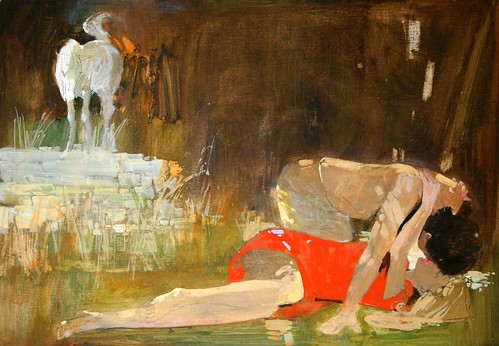
That summer of ’54 we were finally able to be alone together. And gradually he returned to work. We married in December of 1954 and lived in the city at 333 E. 63 St. before moving to Forest Hills, L.I. for the next few years. From then on came some of his best works for all the women's magazines... Good Housekeeping, Redbook, Ladies Home Journal, Woman’s Day, McCalls.

I was still working at Rahl and so I arranged models and props for Andy, reference materials. And much as I adored him, he was THE most demanding and difficult person I worked for at the studio! I chalk that up to a combination of his initial insecurity -- and his intensely high standards. So, I muttered under my breath some real nasty things as I went about doing all his bidding. Jerry Kornblau, the studio photographer, would affirm that Andy sometimes would take as many as 75 shots to get the ONE he wanted to use. Andy also made demands that were different from the other artists. On occasion, he particularly like to do overhead shots for their new-angle design capabilities. I recall the tall ladder . . . and Andy teetering with his Rolleiflex.
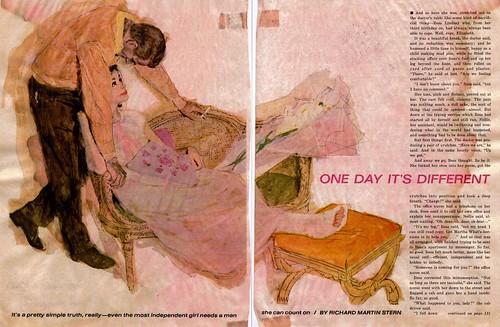
Despite all Andy’s tense fuss and bother when preparing his jobs, Jerry and his wife Audrey, Andy and I became and remained close friends in the following years. Long past the Rahl days. You could not help but love Andy if you were among the few who knew how dedicated and great his work was, how special he was as a human being -- and how downright funnier-than-Hell he could be when he hauled out his dry wit. Like just the spritz of vermouth that makes the icy martini! He and Jerry were also ardent poker buddies.
In his illustrations Andy used many models who later became movie actresses but his favorite and first was brunette and petite-for-a-model, Dorian Leigh. (We gave our daugher "Leigh" as her middle name in honor of that beautiful-looking woman.) Dorian was a success years after when she opened the first modeling agency in Paris. And, no longer the sylph, she wrote a pancake cookbook I saw her hawking on late night tv. Her sister, Suzy Parker, was another beauty, completely the opposite in looks from Dorian for she had red-hair and was one tall Texan. She was in a '50s film, "The Best of Everything" with Joan Crawford and in one or two films with Cary Grant. Not memorable. Andy used her no more than twice.
Another favorite and ever-professional and dependable model was Tippi Hedren (below, standing).
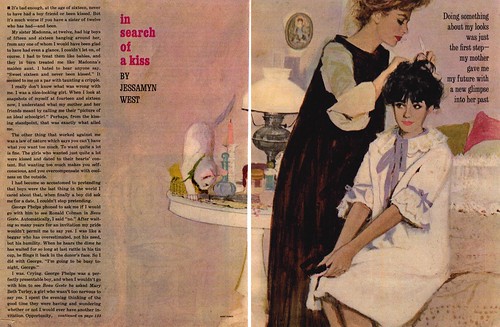
Alfred Hitchcock used her to star in "The Birds". Andy early on used her perfect-to-draw face and figure and hands and feet (rare for a model to be so well put together in all particulars!) very often in commercial jobs as well as in romantic illustrations. There was Tuesday Weld and Maggie Pierce -- later each was in a movie or two. He used Carol Lynley as a child, AKA Carolyn Lee as a movie star when she grew up and played in "The Poseidon Adventure" with Shelley Winters and an all star cast. He also often used a very nice gal, Olga Nicholas. I only knew of her as a model, however. There were four male models he preferred: Bill Clune (below).
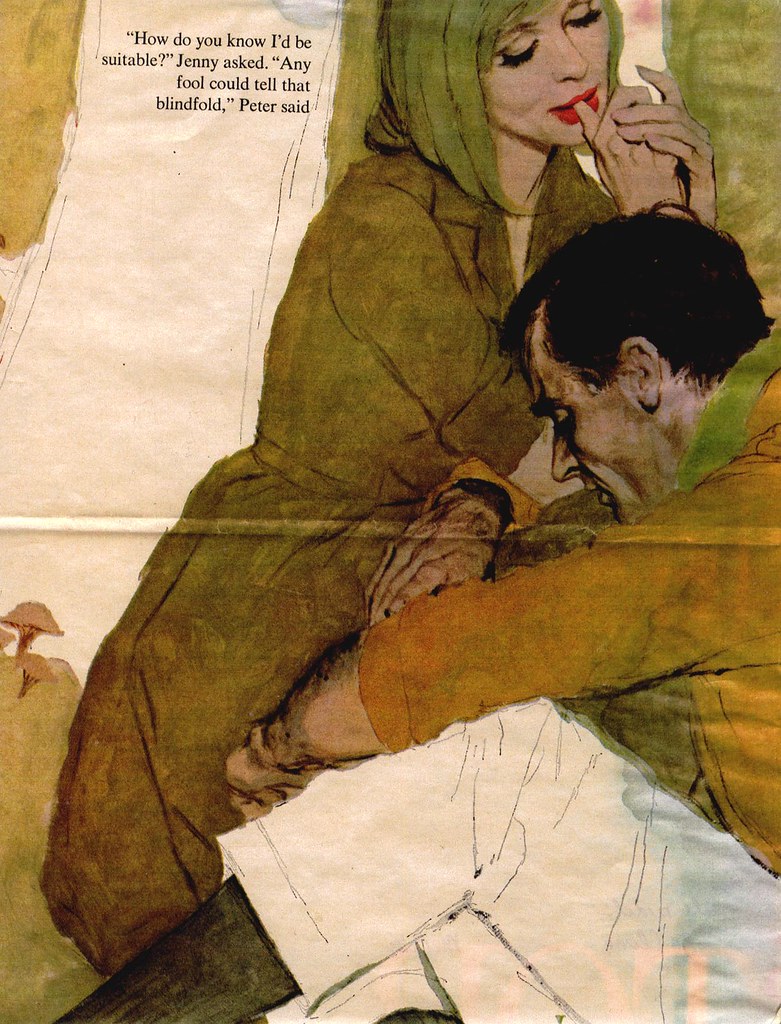
In the earliest years, it was Victor Cutrer (whom Dorian preferred, too -- for other reasons: photographers were known to have to pry them apart in the "clinch" photo sessions). There was also Don Philips. He was a real all-purpose dependable type. And another handsome fellow, Colin Fox who had sailed the Atlantic alone before getting into modeling.

This was a good and busy time at Rahl and a great time for Andy. He worked directly with Herb Mayes at Good Housekeeping, I recall. The work brought into Rahl Studio for all the artists ran the gamut in advertising and illustration art. Accounts from all the women’s magazines using illustration, Field and Stream magazine (Raphael Cavalier did those), spot illustrations of all kinds, big jobs -- most from Madison Avenue giants like Compton Adv., J. Walter Thompson, Kenyon & Eckhardt; out-of-town like Colliers at Curtis Publications out of Philadelphia, BBD&O, etc. So many accounts. For Coke, Pepsi, Ronson, for various soaps, Scott paper products, American Airlines (below)
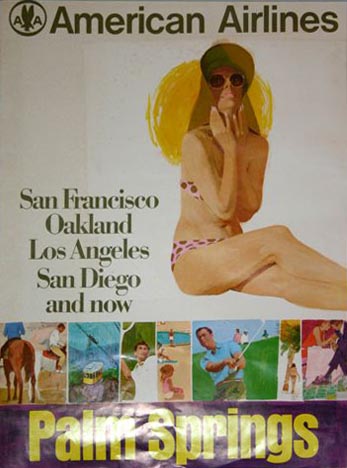
Bantam Books, N.Y. Times magazine section, Seagrams, Ford, General Motors, Dobbs Hats, NJ Bell Telephone, TV Guide, Literary Guild. Comps and finishes abounded. Though not always together.

And then came 1959. By then, I had left Rahl. We had finally bought a wonderful 1847 home in Kinnelon, New Jersey so Andy could at last have his own studio and commute to NYC only to pick up, shoot and and deliver jobs. Andy received a contract for a dozen illustrations, $1250 - $1500 each.

Tomorrow: Something Wrong
Anita Virgil is an internationally anthologized haiku poet. She lives in Forest, Virginia.
Entire contents of these posts on Andy Virgil (both text and pictures) © 2007 Anita Virgil. Nothing may be reproduced without permission of the author.
* A selection of Andy Virgil's original art is available from Graphic Collectibles.
HOLY CRAP!!!!
ReplyDelete$1500 for a magazine illustration in the late '50's ?!
You could probably buy a top of the line Buick for a little over that back then!
The mind boggles....
I love the thought of Andy teetering on a ladder trying to shoot the reference for that wonderful illustration. It reminds me of watching a certain René Milot balancing precariously on a wheeled office chair in my studio last year. Ha, ha, ha.
ReplyDeleteOh, riveting! I am only stopping to leave a comment to say, thank you Anita, for sharing this story about your husband, before I hurry back to read the first three parts. You two sound like you had a fascinating, very full life together! And I *love* Mr. Virgil's work. The moment I saw the scans on Leif's flickr stream, I wanted to mark each one as a favorite; I knew this must be the "special" feature he had mentioned to me ... and he wasn't kidding.
ReplyDeleteHey Shoontz, I wish I could say that I'm no longer shooting references: last week I was on top of a ladder shooting references for an Opera poster: that picture was very close to my reality!
ReplyDelete